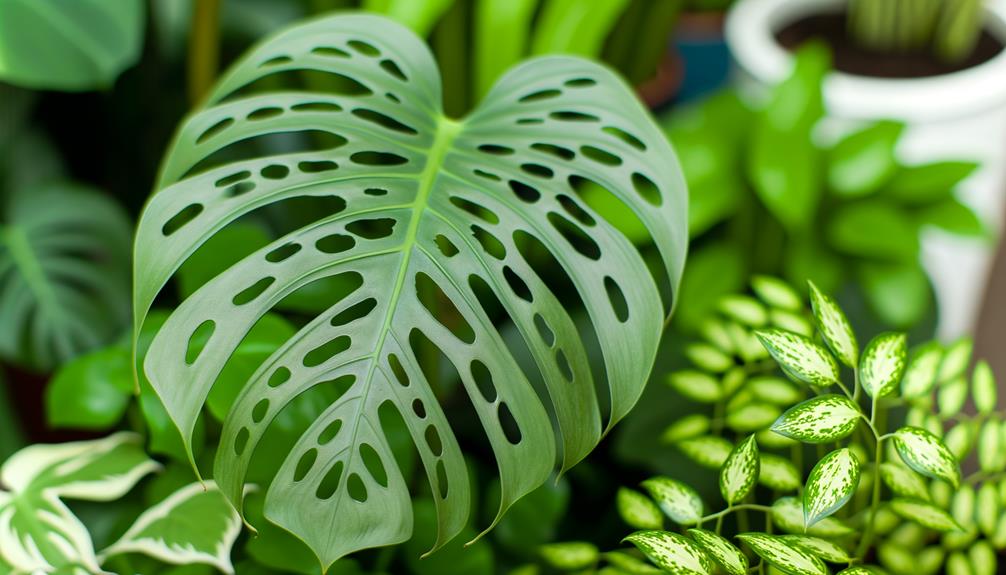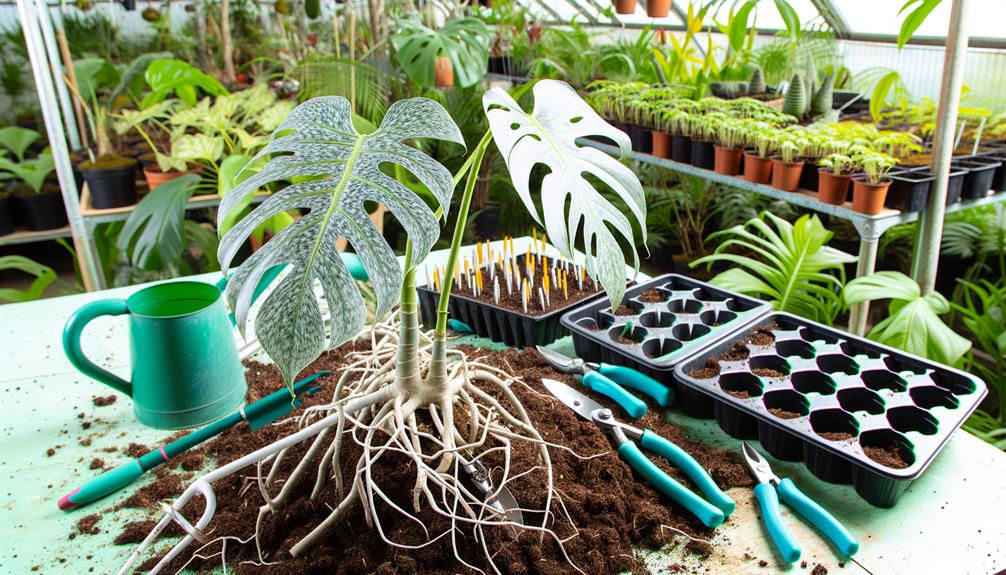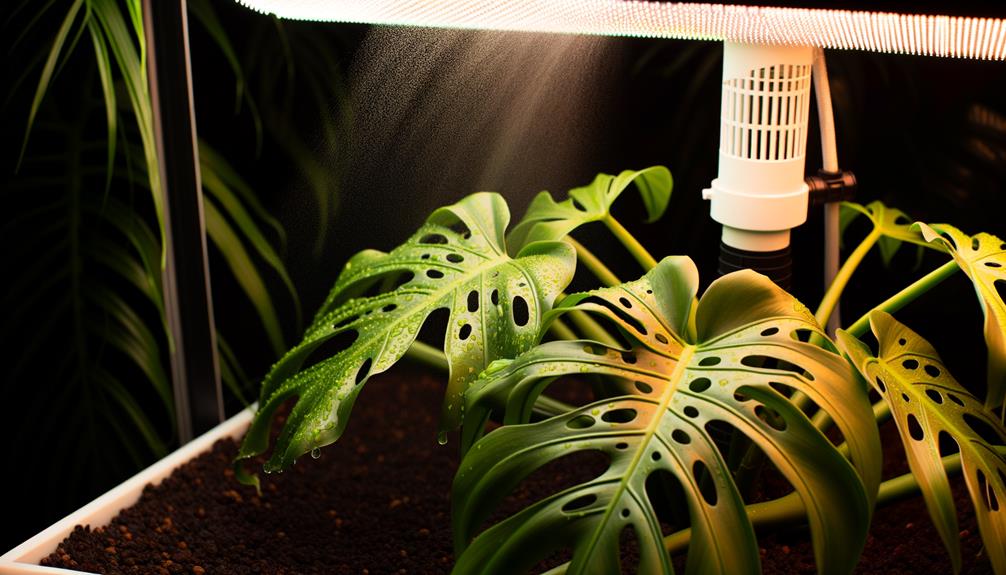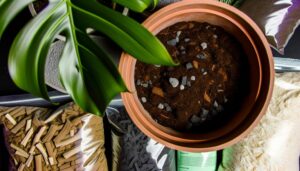Why Is Monstera Obliqua so Expensive
Monstera Obliqua's high cost stems from its rarity, slow growth, and finicky cultivation needs. Originating in Central and South America, it thrives only in specific microclimates.
Its epiphytic nature and delicate structure make propagation labor-intensive. Additionally, it demands precise humidity, bright indirect light, and stable temperatures between 65-80°F.
This high maintenance limits supply. Intense demand from collectors, combined with social media hype, drives prices up further.
Strict import laws and market speculation exacerbate its scarcity. Understanding the interplay of these factors illuminates why this plant remains an expensive and sought-after collector's item.
There's much more to explore.

Key Takeaways
- Monstera Obliqua is rare, with a limited natural habitat in Central and South America.
- The plant grows exceptionally slowly, limiting the number of specimens available for sale.
- Challenging cultivation and propagation conditions require precise humidity, light, and soil composition, increasing costs.
- High demand among enthusiasts and collectors exacerbates the demand-supply imbalance.
- Strict import restrictions and high transportation costs further elevate the plant's market price.
Rarity

Monstera obliqua's rarity stems from its limited natural habitat and the challenging conditions required for successful cultivation. This species thrives primarily in the tropical rainforests of Central and South America, where it faces specific ecological parameters. The microclimatic conditions, such as high humidity, stable temperatures, and diffused light, are hard to replicate outside its native environment.
Moreover, Monstera obliqua's epiphytic nature means it often grows on other plants rather than soil, complicating horticultural efforts. Propagation is also intricate, requiring precise moisture levels and aeration. These factors combined create a scarcity in the market, driving the price up.
Understanding these complexities gives you insight into why this plant commands such high value among enthusiasts.
Slow Growth
You'll find that Monstera obliqua's slow growth greatly limits its propagation speed, impacting its availability.
Coupled with high maintenance needs, such as precise humidity and light conditions, the cultivation process becomes labor-intensive.
These factors collectively contribute to its elevated market price.
Limited Propagation Speed
The propagation speed of Monstera obliqua is particularly slow, primarily due to its limited growth rate and the plant's specific environmental requirements. When you propagate this species, you're dealing with its inherently sluggish development phase, necessitating months to produce a viable new plant.
Monstera obliqua demands exact humidity, temperature, and light conditions, making it difficult to replicate its native tropical habitat in controlled environments. Additionally, the plant's delicate structure and susceptibility to stress further complicate propagation efforts.
This slow propagation rate translates into fewer specimens available for sale at any given time, driving up the market price. By understanding these intricacies, you'll appreciate why Monstera obliqua remains a rare and costly addition to any plant collection.
High Maintenance Needs
Due to its high maintenance requirements, Monstera obliqua demands attentive care to thrive, which greatly contributes to its slow growth rate. You must carefully manage humidity levels, ideally around 80%, to prevent desiccation.
The plant requires indirect but bright light to photosynthesize efficiently without leaf scorching. Soil must remain consistently moist yet well-draining to avoid root rot. Additionally, maintaining stable temperatures between 65-80°F is essential for optimal metabolic function.
Frequent monitoring for pests and diseases is necessary due to its susceptibility to infestations. Each of these precise care requirements slows down the plant's growth, making Monstera obliqua a challenging specimen to cultivate successfully. This high-maintenance nature directly influences its market value and accessibility.
Propagation Challenges

Even with advanced horticultural techniques, propagating Monstera obliqua presents significant challenges due to its delicate nature and specific environmental requirements. You need to maintain precise humidity levels, light conditions, and soil composition to guarantee successful propagation. Root development is often slow, and the plant's fragility makes it susceptible to damage during handling.
Here's a breakdown of the critical factors:
| Factor | Ideal Condition | Challenges |
|---|---|---|
| Humidity | 80-90% | Difficult to sustain |
| Light | Indirect, bright | Risk of leaf burn |
| Soil Composition | Well-aerated, moist | Prone to root rot |
Understanding these propagation challenges helps explain why Monstera obliqua remains elusive and costly.
High Demand
A notably essential factor driving Monstera obliqua's high price is its exceptional demand among plant enthusiasts and collectors. Due to its rarity and unique fenestration pattern, the Monstera obliqua captivates those seeking botanical exclusivity.
The scarcity of the plant, combined with its intricate leaf morphology, fuels an intense market competition. As a result, the limited availability exacerbates the demand-supply imbalance, propelling prices to exorbitant levels.
Collectors often perceive the Monstera obliqua as a status symbol, further amplifying its desirability. Additionally, social media exposure accelerates this demand, as visually striking images of the plant proliferate across platforms, creating a viral effect.
Consequently, the heightened demand noticeably influences its market value, making it one of the most sought-after species in the plant community.
Specialized Care

To guarantee ideal growth, you'll need to carefully manage the Monstera obliqua's humidity and temperature needs, which are essential for its survival.
Adequate light and proper watering practices are necessary to prevent common issues such as root rot.
Additionally, attentive pest and disease management is required to sustain its health and justify its high price.
Humidity and Temperature Needs
Maintaining ideal humidity levels and temperature is fundamental for the thriving growth of Monstera obliqua, given its tropical origins. Aim for 60-80% humidity to replicate its native environment. Lack of sufficient humidity leads to desiccation, impacting leaf morphology and overall health. Utilize a hygrometer to monitor indoor conditions and employ humidifiers or pebble trays to achieve the desired levels.
Temperature regulation is equally important. Keep the Monstera obliqua in a range between 65°F to 80°F (18°C to 27°C). Temperatures below 55°F (13°C) can induce stress, potentially causing irreversible damage. Avoid placing the plant near drafts or in direct path of air conditioning vents.
Proper humidity and temperature management are essential for this delicate species.
Light and Watering Requirements
Ensuring ideal light and watering conditions is vital for the specialized care of Monstera obliqua, given its sensitivity to environmental factors. This plant thrives in indirect, bright light, replicating its native understory rainforest habitat. Direct sunlight can cause photodamage to its delicate leaves.
For peak hydration, maintain consistent moisture levels without waterlogging the roots, which could lead to root rot. Employ a well-draining soil mix to facilitate proper aeration and water flow.
Here are the key factors:
- Light Requirements: Provide bright, indirect light to prevent leaf scorch.
- Watering Schedule: Keep soil consistently moist but avoid standing water.
- Soil Composition: Use a well-draining soil mix to ensure ample root aeration.
Understanding these conditions guarantees your Monstera obliqua flourishes.
Pest and Disease Management
Addressing pest and disease management for Monstera obliqua demands vigilance and timely intervention to prevent infestations and infections from compromising the plant's health. Regularly inspect the leaves for signs of common pests like spider mites, aphids, and mealybugs. Use neem oil or insecticidal soap to manage infestations.
Additionally, maintain ideal humidity levels to reduce the risk of fungal and bacterial diseases. Promote proper air circulation around the plant to prevent issues like root rot and leaf spot. Quarantine new plants before integrating them into your collection to avoid introducing pathogens.
Limited Availability
The limited availability of Monstera Obliqua is primarily driven by its slow growth rate and the challenging propagation conditions required to cultivate this rare plant. You'll find that these factors make it particularly scarce:
- Growth Rate: Monstera Obliqua grows exceptionally slowly, often taking several years to reach a mature size. This greatly limits the number of specimens available for sale.
- Propagation Difficulty: Successful propagation requires precise environmental conditions—humidity, temperature, and light must be meticulously controlled, which isn't easily replicated outside its natural habitat.
- Natural Habitat: Indigenous to specific regions in Central and South America, Monstera Obliqua's natural occurrence is rare, and its collection is strictly regulated to prevent overharvesting.
Understanding these constraints helps explain why Monstera Obliqua commands such high prices.
Import Restrictions

When considering the high cost of Monstera obliqua, you must account for stringent quarantine measures that impact its importation. Limited import licenses exacerbate the scarcity, while high transportation costs further escalate the final price.
These factors collectively contribute to the plant's elevated market value.
Strict Quarantine Measures
Stringent import restrictions significantly impact the availability and price of Monstera obliqua, creating challenges for buyers and sellers alike. Quarantine measures are essential to prevent the spread of pests and diseases, but they also create logistical hurdles.
You'll find that these restrictions lead to:
- Extended Quarantine Durations: Plants must undergo prolonged quarantine, increasing holding costs.
- Increased Inspection Rigor: Enhanced scrutiny by agricultural inspectors raises the likelihood of shipment rejections.
- Elevated Compliance Costs: Meeting strict health and safety standards requires meticulous documentation and specialized treatments.
These factors cumulatively inflate the cost and reduce the quantity of Monstera obliqua in the market. Consequently, you're paying a premium not just for the plant itself but for the rigorous processes ensuring its safe importation.
Limited Import Licenses
Limited import permits further restrict the availability of Monstera obliqua by strictly regulating the number of plants that can legally enter the country. You'll find that these permits are often restricted due to phytosanitary regulations designed to prevent the introduction of pests and diseases.
Regulatory authorities impose quotas, creating a bottleneck in the supply chain. Consequently, the scarcity induced by these import restrictions drives up the market price.
Moreover, the application process for these permits is rigorous and time-consuming, involving compliance with international trade laws and various certifications. This intricate bureaucratic process dissuades many potential importers, further limiting the influx of Monstera obliqua.
Therefore, understanding these regulatory constraints is essential to grasping why the price remains so elevated.
High Transportation Costs
In addition to restrictive import licenses, exorbitant transportation costs further compound the scarcity and high market price of Monstera obliqua. When you consider the logistical complexities, it's clear why the expenses are so steep.
- Special Handling Requirements: Monstera obliqua plants demand specialized packaging to prevent damage during shipment, necessitating costly materials and techniques.
- Climate-Controlled Shipping: These tropical plants require precise temperature and humidity control, which means they must be shipped in climate-controlled environments, escalating transportation costs.
- Customs and Tariffs: Importing Monstera obliqua involves dealing with various customs regulations and tariffs, which add significant extra costs to the final price.
These factors collectively drive up the price, making Monstera obliqua an expensive and sought-after plant in the market.
Market Speculation
Given the high demand and limited supply of Monstera obliqua, market speculation has driven prices to unprecedented levels, often influenced by factors such as rarity, plant condition, and buyer sentiment. You might notice that speculative trends amplify price volatility.
Collectors and sellers frequently engage in bidding wars, pushing prices higher. Scarcity perception often leads to inflated valuations, despite the actual botanical attributes of the plant.
Additionally, plant condition—like leaf fenestration and overall health—plays an essential role in price determination. Buyer sentiment, driven by social media influence and perceived prestige, further exacerbates price hikes.
Understanding these dynamics helps you navigate the Monstera obliqua market more effectively and make informed purchasing decisions.
Unique Aesthetic

The distinctive fenestration patterns and delicate, lace-like leaves of Monstera obliqua set it apart as a highly coveted specimen among plant enthusiasts. These unique morphological features contribute to its high value.
The leaves exhibit extreme perforation and thinness, optimizing light capture in low-light environments. This is due to evolutionary adaptations in its native habitat.
Consider the following characteristics:
- Fenestration: The intricate holes and splits increase surface area, enhancing photosynthetic efficiency.
- Leaf Texture: The thin, papery quality adds an ethereal aesthetic, appealing to collectors.
- Rare Growth Habit: Monstera obliqua grows slowly and sparsely, making mature specimens particularly rare.
Understanding these traits underscores why Monstera obliqua commands such high prices in the market.
Collector's Item
Among plant collectors, Monstera obliqua stands out as a prized specimen due to its rarity and distinctive morphological traits. Its fenestrations and delicate foliage make it a sought-after item in horticultural circles. Collectors like you value this plant for several reasons, encapsulated in the table below:
| Aspect | Description |
|---|---|
| Rarity | Found infrequently in natural habitats |
| Morphological Traits | Unique fenestrations and thin leaves |
| Propagation Difficulty | Challenging to cultivate and propagate |
| Market Demand | High demand among serious collectors |
| Investment Potential | Value appreciates over time |
Understanding these aspects can help you appreciate why Monstera obliqua commands such high prices. Its scarcity and unique features create a significant allure, making it a coveted addition to any collection.
Conclusion
Essentially, Monstera obliqua's high price stems from its rarity, slow growth, and propagation challenges. Couple these with high demand, specialized care, and strict import restrictions, and its value skyrockets.
Market speculation further inflates prices, while its unique aesthetic and status as a collector's item seal the deal. Imagine a rare gem, meticulously crafted by nature, accessible only to those who truly understand its worth and complexities—this is why Monstera obliqua commands such a premium.






